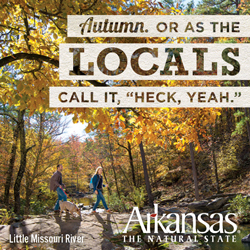The highways and byways of the Grand Central states deliver expansive panoramas and scenic overlooks, historic sites and roadside monuments.
But not all byways are created equal. The Old Trails Road Scenic Byway in western Missouri is only 15 miles long while the stretch of Route 66 through Oklahoma unspools for more than 400 miles across the state. Some offer little more than breathtaking vistas; others have little in the way of scenery but deliver plenty of history.
Route 66
Oklahoma
It’s the classic dream, the romance of the road trip: driving Route 66 from Chicago’s Lake Michigan shores to California’s Pacific Coast. But the stretch through Oklahoma has its own claim to fame.
Cyrus Avery, a Tulsa native, was responsible for Route 66 dipping down into Oklahoma rather than running through Kansas, and that makes Avery the father of the Mother Road.
“He’s known as the father of Route 66,” said Todd Stallbaumer, consumer and trade marketing director for the Oklahoma Tourism and Recreation Department. “He was from Tulsa, and when they were developing the route, he made sure the most drivable miles were through his home state.”
Although there are plenty of stops and sites along the route — the state has identified 87 — some highlights are the Coleman Theater in Miami, near the Kansas border, and the Cyrus Avery Plaza in Tulsa, where the “East Meets West” sculpture depicts a stagecoach encountering a horseless carriage.
In Stroud, the Rock Café has been dishing up diner fare since 1939. Cafe owner Dawn Welch was the primary inspiration for Sally Carrera, the Porsche in Disney’s 2006 movie “Cars.” As travelers continue into Chandler, the Route 66 Interpretive Center tells the road’s story, mainly through video, Stallbaumer said.
In Oklahoma City, Route 66 had three routes through the city over the years. Historic Route 66 runs alongside sections of both interstates 40 and 44.
As visitors continue west through the state, they may want to stop at the Oklahoma Route 66 Museum in Clinton or the National Route 66 Museum in Elk City.

Frontier Military Historic Byway
Kansas
Pivotal events in our nation’s history have taken place on the Kansas frontier, and the Frontier Military Historic Byway provides an opportunity for groups to explore that legacy. The byway runs nearly parallel to the Missouri border from Fort Leavenworth near Kansas City south to Fort Scott and ending at Baxter Springs at the Oklahoma border.
The 168-mile, four-lane highway follows U.S. Route 69, a trail that was originally built to transport soldiers and supplies, but it’s also a symbolic dividing line where 1800s civilization met uncharted territory, where proslavery sentiment clashed with abolitionist settlers, where the Old East met the Wild West.
Fort Leavenworth is an active Army base that was established in 1827 to protect the Santa Fe Trail. Because the fort is still active, visitors may not have access to some buildings, but they can still tour the base and visit the national cemetery there. Step-on guides are available for historical tours, said Kelli Hilliard, travel development manager at the Kansas Department of Wildlife, Park and Tourism. The on-base Frontier Army Museum is free and open to the public Tuesdays through Saturdays.
On the southern end of the trail is Fort Scott, which was established in 1842. The Fort Scott National Historic Site comprises 20 buildings that visitors can tour, 11 that are original and the rest rebuilt on original foundations. Re-enactors and interpreters, many wearing period costumes, tell the story of the frontier in the mid-1800s through military drills, artillery demonstrations and daily activities.
Along the byway, travelers can also stop at Marais des Cygnes Massacre Memorial Park, the site where a proslavery group shot 11 free-staters in 1858. The massacre was one of the last Bleeding Kansas encounters before the Civil War broke out.
Minecreek Battlefield State Historic Site is where an 1864 battle took place. The visitor center is open April through October, and guests can walk along a nature trail through the state’s only major Civil War battle site.










